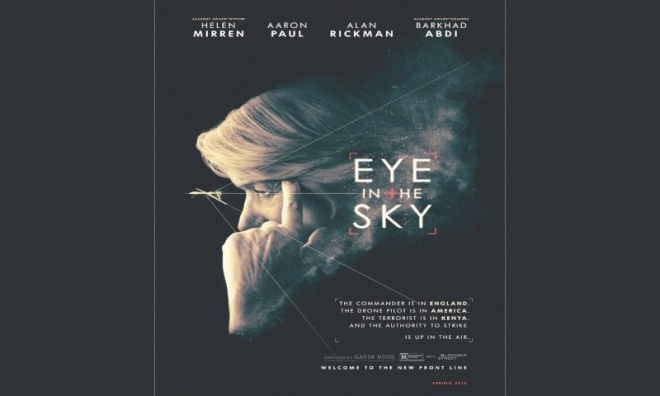
Monday, April 18, 2016

advertisements
Until quite recently, we heard of drones only in the context of the deadly strikes against extremist targets in Pakistan’s tribal areas, Afghanistan, Yemen and Somalia. These Unmanned Aerial Vehicles (UAVs) generated a lot of heat and noise in Pakistan’s TV studios, as well as in human rights groups across the world. But nobody has so far offered an alternative.
Suddenly, drones have become ubiquitous: from kids to police departments to the news media, everybody is using them. Luckily, these UAVs are not (yet) armed, and only carry cameras, but they are filling the skies to an uncomfortable degree. Reporters and paparazzi are using these remote cameras to intrusively film celebrities, while the police in some countries are following suspected criminals from high above.
Despite the rapid deployment of drones in all kinds of roles, there has been little debate about the morality of their use. But in a film I saw recently, there is a serious attempt to open an honest discussion about collateral damage resulting from drone attacks even against known terrorists.
Eye in the Sky is a tense thriller filmed from different vantage points. Directed by Gavin Hood, the movie’s star is the brilliant Helen Mirren who plays Katherine Powell, a British army colonel who has been tracking a group of terrorists for years. They finally gather together in a safe house on the outskirts of Nairobi and are observed by a drone, controlled by the British via pilots based in Nevada.
However, under the rules of engagement, a number of precautions have to be taken, chief among them being the need to minimise — if not avoid — civilian casualties. One army expert operates a software program that generates a Collateral Damage Estimation (CDE) based on the kind of missile the drone will launch, its blast radius and where precisely it will hit.
To obtain photographs of the suspected terrorists inside the safe house, tiny robots in the shape of a hummingbird and a beetle are deployed. Controlled by a Kenyan intelligence agent, the photos obtained permit the identities of the terrorists to be confirmed within seconds.
As we watch two volunteers, including one American of Somali origin, put on their suicide vests, we know an attack is to be launched very soon. Colonel Powell asks for authorisation to release the Hellfire missile mounted on the drone. However, the committee supervising the operation wants approval from the foreign secretary. He is in South Korea, suffering from acute diarrhoea, and passes the buck on to the prime minister who happens to be in Brussels. As there is an American citizen in the safe house, he refers the matter to the US secretary of state who is in China.
In the midst of all this dithering, the Americans are absolutely clear: go for it is their clear advice to the British. But then a moral dilemma in the form of a little girl appears. We have watched her playing in her backyard, and reading in her house without knowing that she lives right next to the safe house. Just as preparations are being made for launching the missile, she takes several loaves of bread baked by her mother and sets up her table right outside the target building.
By now, our sympathy is engaged with the girl, and we don’t want to see her die. Neither, it seems, does the controller of the drone. As the girl settles down to sell her bread, he watches on his camera feed, and demands a revised CDE. This new estimate shows her to be clearly in the blast area. A junior minister who is a member of the committee now refuses to go along with the majority view that the missile should be launched before the suicide bombers leave the house. The others argue that the life of a single girl should not outweigh those of scores of possible victims.
The colonel, desperate for a decision, changes the point of impact slightly, and pressures the junior officer to revise his CDE downwards to reduce the chance of the girl being killed from 70pc to 40pc. This swings the balance, and the launch is authorised. I will not reveal the ending as I don’t want to spoil the movie for those readers who will watch it.
While this edge-of-the-seat thriller does raise important moral issues, it is still fiction. As far as we know, such questions as the percentage of likelihood of civilian casualties don’t play much of a role in real life, and nor do drone operators raise questions about collateral damage. However, there have been reports of quick burnout among these ‘armchair pilots’ as they are known among professional air force personnel.
And the head of Reprieve, the anti-capital punishment group, Clifford Stafford Smith, debunks the identification technology depicted so convincingly in the film. Although he served as a consultant to the director, Smith says that in reality, poor imaging is often responsible for suspects to be misidentified and wrongly targeted.
But despite the many flaws — all too often fatal — that drone technology suffers from, it is still the most precise weapon system available for eliminating terrorists, especially for those sheltering among civilians. Drones can loiter thousands of feet above their targets for hours, and launch missiles with a degree of precision no manned aircraft can match.
However, as we have seen over the years, drones can minimise collateral damage, but cannot completely eliminate it. As most militants often use civilians as human shields, even the most accurate weapon cannot avoid killing or wounding those in the immediate vicinity. And as far as I know, the Americans do not have the layers of control shown in Eye in the Sky: once a target has been identified, it is as though a death sentence had been passed.